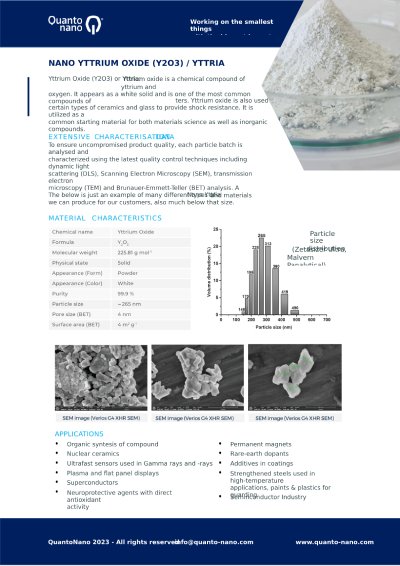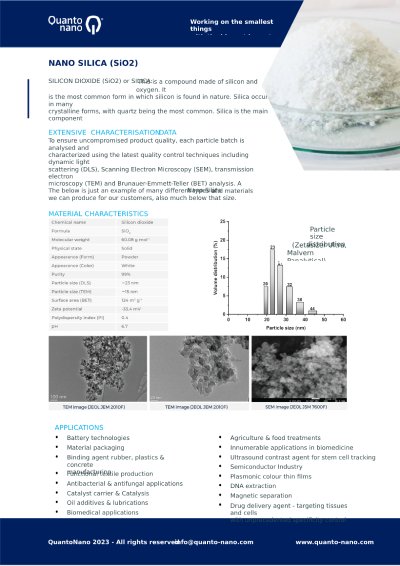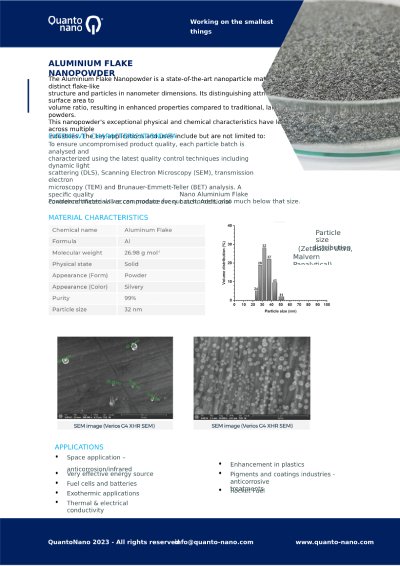Nano Materials
Active Battery Material
Nano active materials significantly enhance battery performance, energy density, and safety. Nano-sizing these materials improves their electrochemical properties, increasing energy density, rate capability, and cycle life.
Quanto Nano
Product Categories
Quanto Nano
Lithium Cathode Materials
Predominantly used in consumer electronics, offering high energy density
Send Inquiry
Send Inquiry
Provides good thermal stability and rate capabilities, suitable for power tools and electric vehicles.
Send Inquiry
Send Inquiry
Noted for safety and long cycle life, ideal for electric vehicles and stationary storage.
Send Inquiry
Send Inquiry
Suitable for high-energy-density batteries in electric vehicles and portable electronics.
Send Inquiry
Send Inquiry
High energy density; used in premium electronics and electric vehicles.
Send Inquiry
Send Inquiry
Rapid charge capabilities; used in high charge/discharge rate applications.
Send Inquiry
Send Inquiry
Quanto Nano
Other Cathode Materials
These are gaining attention in both anode and cathode applications, with promising properties like high capacity and conductivity.
Send Inquiry
Send Inquiry
In cathodes composed of nickel-rich materials like NMC (Nickel Manganese Cobalt Oxide) and NCA (Nickel Cobalt Aluminum Oxide), nanosizing can help manage issues such as material degradation and thermal instability, especially at high states of charge.
Send Inquiry
Send Inquiry
Nanoscale vanadium oxide can be used in cathodes for its high energy and power density. Its layered structure at the nanoscale allows for fast lithium-ion intercalation, making it suitable for high-power applications.
Send Inquiry
Quanto Nano
Active Anode Materials
The most common anode material, known for stability and capacity.
Send Inquiry
Send Inquiry
Offers high cycle stability and fast charging, used in specialized applications.
Send Inquiry
Send Inquiry
Promises a higher capacity than graphite, although challenges remain in handling volume expansion.
Send Inquiry
Send Inquiry
Offers higher capacity but faces similar challenges with volume changes.
Send Inquiry
Send Inquiry
Enhances conductivity and mechanical stability, used in combination with other anode materials to boost performance.
Send Inquiry
Send Inquiry
These are explored for anodes in lithium-ion batteries due to their stability, safety, and ability to accommodate volume changes.
Send Inquiry
Send Inquiry
These are gaining attention in both anode and cathode applications, with promising properties like high capacity and conductivity.
Send Inquiry
Send Inquiry
Nanosized LMO can offer improved rate capabilities and thermal stability. The nanostructure can help in managing the strain and structural changes during battery operation, enhancing both performance and safety.
Send Inquiry
Send Inquiry
Nanostructured titanates, like barium titanate, can be used in battery anodes, offering advantages in terms of safety and rate capability.
Send Inquiry
Send Inquiry
Materials like iron phosphide (FeP) or molybdenum sulfide (MoS2) in nanoscale form can serve as high-capacity anode materials, benefiting from enhanced electrical conductivity and structural integrity.
Send Inquiry
Send Inquiry
As a potential low-cost alternative to lithium-ion batteries, sodium-ion batteries can benefit from nanosized active materials like sodium cobalt oxide or sodium manganese oxide, improving their charge storage and cycling stability.
Send Inquiry
Send Inquiry
The use of nanosized sulfur and carbon composites in Li-S batteries can address the challenges of poor conductivity and the polysulfide shuttle effect, significantly improving their cycle life and energy density.
Send Inquiry
Send Inquiry
Nanostructured conductive polymers can enhance the electrical conductivity and mechanical flexibility of electrodes, potentially leading to more durable and efficient batteries.
Send Inquiry
Send Inquiry
Summary
The development of advanced materials in battery technology, including nano active cathode and anode materials, and solid-state electrolytes like Li6PS5Cl, represents a significant stride in battery innovation. These materials are key to overcoming current limitations of lithium-ion batteries, offering prospects for safer, higher energy density, and more durable battery systems. The research and development in this field are crucial for the future of energy storage, electric vehicles, and portable electronics

WE WORK ON THE SMALLEST THINGS WITH THE BIGGEST IMPACT











